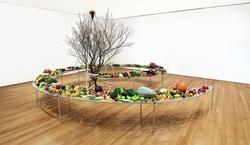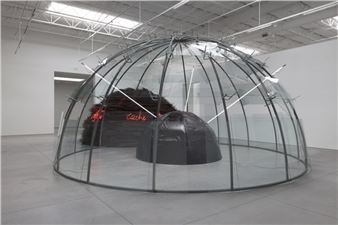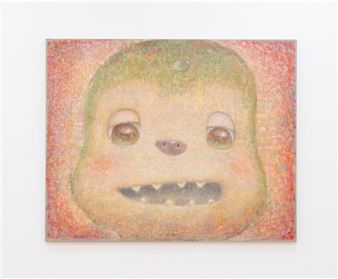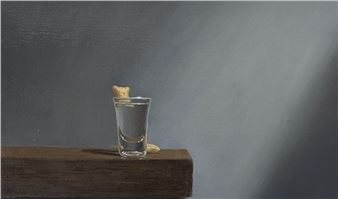Mario Merz: Works from the 1980s
MerzÔÇÖs work is heavily informed in both form and content by the logic of the Fibonacci sequence of numbers ÔÇô the mathematic sequence in which each integer is determined by the sum of the two preceding numbers. This sequence finds symbolic expression in the spiral form that recurs throughout MerzÔÇÖs work. Tavola a spirale (Spiral table), 1982, ties the sense of natural profusion directly to the tableÔÇÖs symbolic importance as a place of gathering. Offerings of fresh fruits and vegetables accumulate on these tables, at times massed into bountiful piles, at times organized into neat patterns.
Merz incorporates these natural networks to relate both literally and metaphorically to issues of social organization. ÔÇ£Because the Fibonacci numbers were progressive, and each was incorporated in the next, Merz felt they aptly expressed the relationship between a single unit and a mass, between the individual and society at large,ÔÇØ notes an Albright-Knox catalogue of the artistÔÇÖs work. Merz saw the Fibonacci sequence as framework through which the described growth pattern of certain forms of life allows the world to become increasingly clearer.
In Quattro tavole in forma di foglie di magnolia (Four tables in the shape of magnolia leaves),1985, natural beeswax forms the surface of the welded steel from which various organic and manmade elements are suspended. The tables themselves assume the shape of magnolia leaves, which grow according to a Fibonacci progression, and suggest, like the Tavola a spirale, a potentially endless proliferation. With their constantly changing elements, MerzÔÇÖs tables are perhaps the most radically open of the artistÔÇÖs works, and gesture toward the broader sense of community the artist sought to engender.
The wide range of materials, forms, and concepts employed in MerzÔÇÖs work also suggests a nomadic association to nature. Bisonti (Bison),1982, a canvas spanning more than 19 feet, depicts two bison beneath a colorful arc bearing the faintly scrawled line; the artist states ÔÇ£Se la forma scompare, la sua radice ├¿ eternal (If the form vanishes, its root is eternal).ÔÇØ Merz extends the bisonÔÇÖs hooves below the canvas to enter the space of the viewer, which upon closer inspection emerge as painted shoeboxes. An even larger untitled painting from 1983 has a more diffuse sense of animal energy, its leaf-like or wing-like forms expand outward from the edges of the canvas, snaking along the large wall it occupies. According to Merz these paintings ÔÇ£have something ancient about them, a sense of the unknown, of unavailabilityÔÇØ that exhibit a juxtaposition of vernacular objects with timeless subject matter.
In Noi giriamo intorno alle case o le case girano intorno a noi? (Do we surround the houses or do the houses surround us?), 1982, vellum paintings with vivid yet ambiguous animal motifs are mounted on bamboo poles in the form of a lantern-like primitive structure. Anchored to the ground by clay feet, the work opens outward to embrace the conditions of its own display, expressing MerzÔÇÖs notion that ÔÇ£painting is a thingly process, not subject to photographic consumption.ÔÇØ

Recommended for you
MerzÔÇÖs work is heavily informed in both form and content by the logic of the Fibonacci sequence of numbers ÔÇô the mathematic sequence in which each integer is determined by the sum of the two preceding numbers. This sequence finds symbolic expression in the spiral form that recurs throughout MerzÔÇÖs work. Tavola a spirale (Spiral table), 1982, ties the sense of natural profusion directly to the tableÔÇÖs symbolic importance as a place of gathering. Offerings of fresh fruits and vegetables accumulate on these tables, at times massed into bountiful piles, at times organized into neat patterns.
Merz incorporates these natural networks to relate both literally and metaphorically to issues of social organization. ÔÇ£Because the Fibonacci numbers were progressive, and each was incorporated in the next, Merz felt they aptly expressed the relationship between a single unit and a mass, between the individual and society at large,ÔÇØ notes an Albright-Knox catalogue of the artistÔÇÖs work. Merz saw the Fibonacci sequence as framework through which the described growth pattern of certain forms of life allows the world to become increasingly clearer.
In Quattro tavole in forma di foglie di magnolia (Four tables in the shape of magnolia leaves),1985, natural beeswax forms the surface of the welded steel from which various organic and manmade elements are suspended. The tables themselves assume the shape of magnolia leaves, which grow according to a Fibonacci progression, and suggest, like the Tavola a spirale, a potentially endless proliferation. With their constantly changing elements, MerzÔÇÖs tables are perhaps the most radically open of the artistÔÇÖs works, and gesture toward the broader sense of community the artist sought to engender.
The wide range of materials, forms, and concepts employed in MerzÔÇÖs work also suggests a nomadic association to nature. Bisonti (Bison),1982, a canvas spanning more than 19 feet, depicts two bison beneath a colorful arc bearing the faintly scrawled line; the artist states ÔÇ£Se la forma scompare, la sua radice ├¿ eternal (If the form vanishes, its root is eternal).ÔÇØ Merz extends the bisonÔÇÖs hooves below the canvas to enter the space of the viewer, which upon closer inspection emerge as painted shoeboxes. An even larger untitled painting from 1983 has a more diffuse sense of animal energy, its leaf-like or wing-like forms expand outward from the edges of the canvas, snaking along the large wall it occupies. According to Merz these paintings ÔÇ£have something ancient about them, a sense of the unknown, of unavailabilityÔÇØ that exhibit a juxtaposition of vernacular objects with timeless subject matter.
In Noi giriamo intorno alle case o le case girano intorno a noi? (Do we surround the houses or do the houses surround us?), 1982, vellum paintings with vivid yet ambiguous animal motifs are mounted on bamboo poles in the form of a lantern-like primitive structure. Anchored to the ground by clay feet, the work opens outward to embrace the conditions of its own display, expressing MerzÔÇÖs notion that ÔÇ£painting is a thingly process, not subject to photographic consumption.ÔÇØ

 ARTISTS
ARTISTS
















